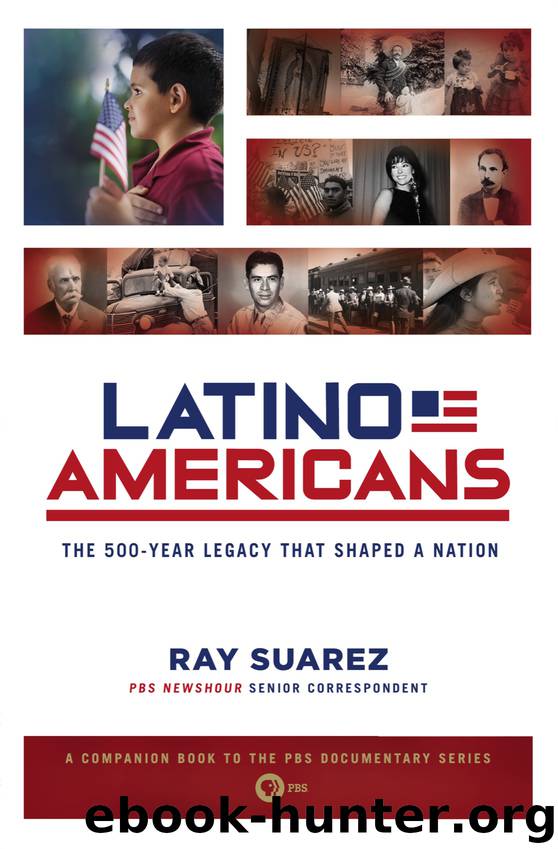Latino Americans by Ray Suarez

Author:Ray Suarez
Language: eng
Format: epub
Publisher: Penguin Group US
Published: 2013-07-24T16:00:00+00:00
• • •
IN 1957, PLAYWRIGHT Arthur Laurents and composer Leonard Bernstein dusted off the old love-across-ethnic-barriers idea for a new Broadway musical. This one would not have a “we’re all human after all” comedic kumbaya at the end, like Abie’s Irish Rose. It was to be a retelling of Shakespeare’s Romeo and Juliet with warring clans and young death. The original title was East Side Story, with a Jewish Juliet falling for an Italian-American Romeo. The newspapers of the day were full of gang wars, but by the late 1950s increasingly middle-class and suburbanizing New York Jews were a tougher fit for the Montagues or the Capulets reimagined as street toughs.
One gang, the Jets, became a motley collection of working-class whites. The other, the Sharks, was composed of the new kids on the block, Puerto Ricans. Now West Side Story, the show opened on Broadway to wide acclaim, with two of the leading Puerto Rican roles played by Carol Lawrence as Maria and Ken LeRoy as Bernardo. Chita Rivera, the daughter of a Puerto Rican–born musician and a U.S.-born mother, played Bernardo’s sister, Anita.
While West Side Story continued its Broadway run, the low-intensity conflict on the streets of tough New York neighborhoods left the realm of Leonard Bernstein and Stephen Sondheim’s Tony Award–winning ballads and splashed onto the front pages of the New York tabloids.
Though the Irish, Italians, and Jews of earlier generations had all been through it, Puerto Rican gang membership was portrayed as a new and different kind of menace. While white boys of many ethnic backgrounds still joined gangs, it was black and Puerto Rican gang membership that was most widely discussed in the press, studied by commissions, and worried over by the grandchildren of ancestors who lived in neighborhoods that were rife with gang enterprises and gang violence.
Edwin Torres, jurist, author, and son of Spanish Harlem, watched it all unfold in the late 1940s and early 1950s. “There were gang wars going on. There was a pool hall at 106th and Madison—and I was hanging out there with my pals from the ’hood. My father happened to walk by and saw me. He rapped on the window—to come out. He told me, ‘Go back in there, finish your game—but this is the last time you set foot in there.’ He always said there is only one way out of here: los libros, the books.”
Torres did as he was told. He was the only Puerto Rican student at the elite public Stuyvesant High School, and then attended the City University of New York. After service in the Korean War, Torres went to Brooklyn Law School on the GI Bill, and was a celebrated symbol of “making it” when he became the first Puerto Rican assistant district attorney in New York. The boy whose success at school sent him to college instead of the gangs was assigned to the Capeman case, forever intertwining his life with that of a young killer who illustrated a different side of Puerto Rican life in New York.
Download
This site does not store any files on its server. We only index and link to content provided by other sites. Please contact the content providers to delete copyright contents if any and email us, we'll remove relevant links or contents immediately.
| African-American Studies | Asian American Studies |
| Disabled | Ethnic Studies |
| Hispanic American Studies | LGBT |
| Minority Studies | Native American Studies |
Cecilia; Or, Memoirs of an Heiress — Volume 1 by Fanny Burney(31333)
Cecilia; Or, Memoirs of an Heiress — Volume 3 by Fanny Burney(30934)
Cecilia; Or, Memoirs of an Heiress — Volume 2 by Fanny Burney(30889)
The Great Music City by Andrea Baker(21313)
We're Going to Need More Wine by Gabrielle Union(18072)
Bombshells: Glamour Girls of a Lifetime by Sullivan Steve(13108)
Pimp by Iceberg Slim(12931)
All the Missing Girls by Megan Miranda(12747)
Fifty Shades Freed by E L James(12451)
Norse Mythology by Gaiman Neil(11883)
Talking to Strangers by Malcolm Gladwell(11877)
Crazy Rich Asians by Kevin Kwan(8349)
Mindhunter: Inside the FBI's Elite Serial Crime Unit by John E. Douglas & Mark Olshaker(7834)
The Lost Art of Listening by Michael P. Nichols(6474)
Enlightenment Now: The Case for Reason, Science, Humanism, and Progress by Steven Pinker(6405)
Bad Blood by John Carreyrou(5769)
The Four Agreements by Don Miguel Ruiz(5511)
Weapons of Math Destruction by Cathy O'Neil(5037)
We Need to Talk by Celeste Headlee(4869)
